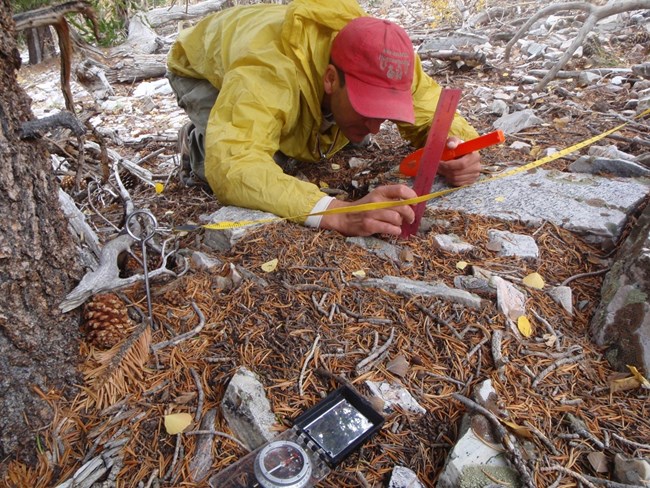Part of a series of articles titled The Midden - Great Basin National Park: Vol. 17, No. 1, Summer 2017.
Article
Measuring Fuels in Bristlecone Pine Communities
This article was originally published in The Midden – Great Basin National Park: Vol. 17, No. 1, Summer 2017.

Great Basin bristlecone pines (Pinus longaeva) are among the oldest organisms on earth, an icon of western forests. Bristlecone pines grow at the highest elevations in mountain ranges of the Great Basin in the western United States, and many park visitors have seen the ancient groves.
Bristlecone pines also grow in mid elevation mixed conifer forests, and sometimes even in low elevation forests.
Growing mostly high on mountain peaks, Great Basin bristlecone pine ecosystems are naturally fragmented. Fires are infrequent in high elevation bristlecone pine forests due to sparse fuels, and little was previously known about fuels in these forests. However, recent fire activity in Great Basin bristlecone pine forests (e.g., the Phillips Ranch Fire, 2000; Amos Canyon Fire, 2009; and the Carpenter 1 Fire, 2013) have burned many ancient trees. When fires do occur at high elevations, they are usually small, low-severity, surface fires.
Our recent research has increased understanding of Great Basin bristlecone pine ecology by examining how fire regimes may change with warming air temperatures. Our objective was to measure discontinuous wildland fuels across changing environmental gradients in bristlecone pine stands. Environmental gradients describe changes in conditions such as elevation, temperature, humidity, and water availability.
Forest composition usually changes along environmental gradients in predictable ways. For example, elevation is a surrogate to approximate changes in temperature and moisture. Understanding how fuel structure and composition varies throughout the Great Basin is useful to predict how fire frequency and intensity may change at high elevations with a changing climate.
We measured changes in fuels from the lowest elevations to the alpine treeline at several locations, including two in Great Basin National Park. Different fuel classes (the down dead vegetation) were tallied from the forest floor and converted to fuel loads. Fine woody debris (sticks, twigs, and pine needles) are the class of fuels that typically allow a wildfire to advance, while coarse woody debris (logs), indicate how long a fire burns at a particular site. During field data collection, we noticed that fuels accumulate directly beneath trees, which were not represented in current monitoring protocols. We measured fuels in north-east-south-west transects below tree trunks. We found that fuels predictably decrease with increasing elevation. At low elevations, fuels are heavy and in close proximity to ignition sources, while becoming too sparse to carry fire at high elevations. With climate change, we might expect high elevation stands to resemble current low and mid elevation stands with an increased risk of forest fires.
For decades, fire suppression has contributed to increases in woody fuels, canopy cover, and fuel continuity, which in turn, leads to larger fires that are more severe as fuels increase and become more connected. Interestingly, however, fire suppression, which produced unnatural fuel accumulations throughout the American West, was not used in high elevation pine forests, where bristlecone pine are located. Although large fires that burn entire bristlecone pine stands are rare, our more precise measurements and analysis identifies elevations that are the most susceptible to fire.
Managing bristlecone pine stands might be unprecedented, but fuels management could have large impacts on preventing large fires in these highly prized communities. The greatest fire threat to bristlecone pines located on high peaks are fires that are ignited at lower elevations on hot, windy days that move into the upper forests. Improved fire and fuels models would help describe the discontinuous fuels for these iconic and fragmented species.
Reference:
Gray, C.A. and Jenkins, M.J. 2017. Climate warming alters fuels across elevational gradients in Great Basin bristlecone pinedominated sky island forests. Forest Ecology and Management, 392:125-136.
Last updated: March 7, 2024
